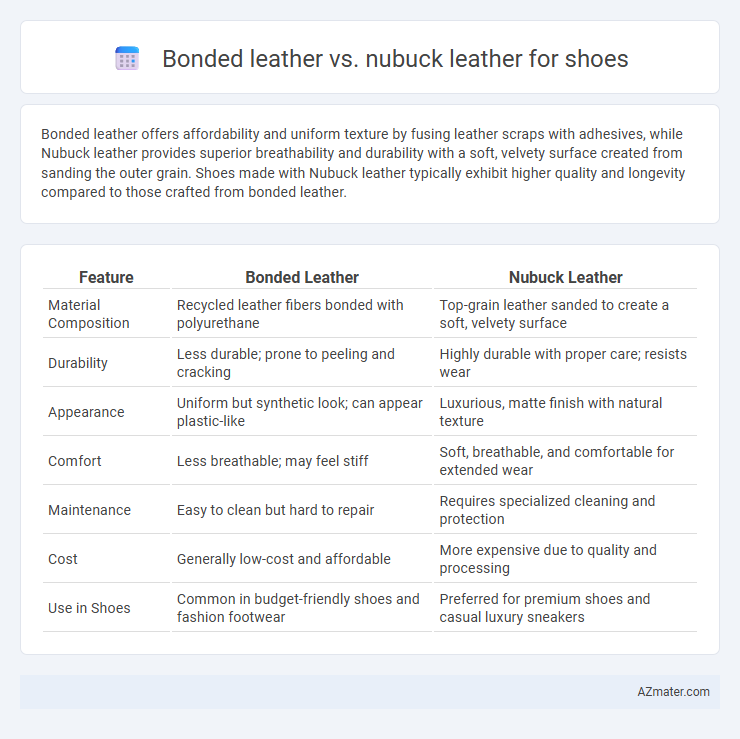Bonded leather offers affordability and uniform texture by fusing leather scraps with adhesives, while Nubuck leather provides superior breathability and durability with a soft, velvety surface created from sanding the outer grain. Shoes made with Nubuck leather typically exhibit higher quality and longevity compared to those crafted from bonded leather.
Table of Comparison
| Feature | Bonded Leather | Nubuck Leather |
|---|---|---|
| Material Composition | Recycled leather fibers bonded with polyurethane | Top-grain leather sanded to create a soft, velvety surface |
| Durability | Less durable; prone to peeling and cracking | Highly durable with proper care; resists wear |
| Appearance | Uniform but synthetic look; can appear plastic-like | Luxurious, matte finish with natural texture |
| Comfort | Less breathable; may feel stiff | Soft, breathable, and comfortable for extended wear |
| Maintenance | Easy to clean but hard to repair | Requires specialized cleaning and protection |
| Cost | Generally low-cost and affordable | More expensive due to quality and processing |
| Use in Shoes | Common in budget-friendly shoes and fashion footwear | Preferred for premium shoes and casual luxury sneakers |
Introduction to Bonded Leather and Nubuck Leather
Bonded leather is a material made by combining shredded leather fibers with polyurethane or latex binders, offering an affordable and eco-friendly alternative to genuine leather. Nubuck leather, derived from top-grain cattle hide, is finely sanded or buffed on the outer surface to create a velvety, soft texture known for its durability and premium appearance. Both materials provide distinctive qualities for shoes, with bonded leather emphasizing cost-effectiveness and versatility, while nubuck leather highlights luxury and breathability.
Composition and Manufacturing Process
Bonded leather is made by shredding leftover leather scraps, mixing them with polyurethane or latex binders, and pressing the mixture onto a fiber backing, resulting in a cost-effective material with inconsistent durability. Nubuck leather is crafted from the outer side of a cowhide, sanded or buffed to create a soft, velvety surface, offering natural breathability and strength due to its full-grain origin. The manufacturing process of bonded leather involves synthetic binding agents that reduce lifespan, while nubuck undergoes careful surface treatment preserving the leather's fibrous structure for enhanced wear resistance.
Appearance and Texture Comparison
Bonded leather shoes exhibit a uniform, smooth surface with a glossy finish, often lacking the natural grain and softness found in genuine leather. Nubuck leather shoes feature a velvety texture with a matte appearance, created by sanding the outer layer of full-grain cowhide, providing a luxurious and supple feel. The distinct texture of nubuck enhances breathability and adds visual depth, making it more desirable for high-quality footwear compared to the synthetic look of bonded leather.
Durability and Longevity
Nubuck leather offers superior durability and longevity compared to bonded leather due to its full-grain structure and natural resistance to wear and tear. Bonded leather, made from shredded leather fibers bonded with polyurethane, tends to deteriorate faster and is less resilient to moisture and abrasion. For shoes requiring long-lasting performance, nubuck leather is the preferred choice because it maintains its integrity over time with proper care.
Comfort and Breathability
Nubuck leather offers superior breathability and comfort compared to bonded leather due to its natural grain and porous texture, allowing better air circulation which reduces moisture buildup inside shoes. Bonded leather, composed of leather scraps and synthetic materials, tends to be less breathable and less flexible, often causing discomfort during extended wear. For footwear prioritizing comfort and ventilation, nubuck leather stands out as the more effective choice.
Maintenance and Care Requirements
Bonded leather shoes require regular cleaning with a damp cloth and occasional conditioning with leather-specific products to prevent cracking and peeling, as their composite nature makes them less durable than natural leather. Nubuck leather shoes demand gentle brushing to maintain their soft, velvety texture and should be protected with water and stain repellents designed for delicate suede-like finishes. Both types benefit from proper storage away from direct sunlight and moisture to preserve their appearance and extend shoe lifespan.
Cost Differences
Bonded leather shoes are significantly more affordable than nubuck leather shoes due to their manufacturing process, which uses leftover leather scraps bonded with polyurethane or latex. Nubuck leather, made from the outer side of a hide and meticulously sanded to create a soft, velvety texture, commands a higher price due to its premium quality and durability. Consumers often choose bonded leather for cost-effectiveness while opting for nubuck when seeking superior aesthetics and long-term wear.
Environmental Impact
Bonded leather is made by compressing leather scraps with adhesives, resulting in a material that relies heavily on synthetic components and adhesives, which can hinder biodegradability and contribute to environmental pollution. Nubuck leather, derived from the top grain of cattlehide and minimally processed, has a longer lifespan and biodegrades more naturally, reducing ecological footprint compared to bonded leather. Choosing nubuck leather supports sustainable practices by emphasizing durability and less chemical interference in the production process.
Common Uses in Shoe Design
Bonded leather is commonly used in budget-friendly shoe designs for its cost-effectiveness and ability to mimic genuine leather's appearance, often featured in dress shoes and casual footwear. Nubuck leather, prized for its soft texture and durability, is popular in high-end sneakers, boots, and outdoor shoes where comfort and premium aesthetics are essential. Shoe designers select bonded leather for affordability and visual appeal, while nubuck leather is favored for longevity and luxurious feel.
Which Leather is Best for Shoes?
Nubuck leather, derived from top-grain cowhide, offers superior durability, breathability, and a soft, velvety texture, making it ideal for high-quality shoes requiring longevity and comfort. Bonded leather, made from leather scraps bonded with polyurethane, is less durable and prone to wear and peeling, often used in budget-friendly footwear but lacking the natural strength and aesthetic appeal of nubuck. For shoe applications demanding both performance and premium appearance, nubuck leather is the preferred choice over bonded leather.

Infographic: Bonded leather vs Nubuck leather for Shoe
 azmater.com
azmater.com